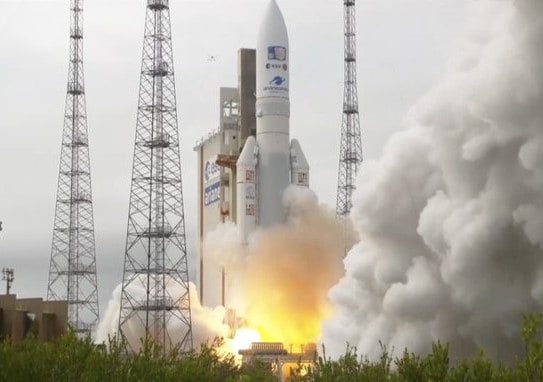The European Space Agency (ESA) has launched a mission to Jupiter that will test the conditions that may have led to the emergence of habitable environments. The €1.6bn Jupiter Icy Moons Explorer (JUICE) was launched today on an Ariane 5 rocket from Europe’s Spaceport in Kourou, French Guiana, at 09:14 local time. JUICE will now take eight years to travel to Jupiter. It is expected to reach the gas giant in July 2031.
As it makes its way to Jupiter, JUICE will perform flybys of Venus, Earth and the Moon to increase its speed and adjust its trajectory. Once at Jupiter it will spend four years investigating the Jupiter system, including how the planet’s complex environment has shaped its moons as well as studying whether there could ever have been life on the moons.
Indeed, the craft will also visit Jupiter’s three large ocean-bearing moons – Ganymede, Callisto and Europa – performing 35 fly-bys, which includes 21 of Callisto and two of Europa.
JUICE will be the first spacecraft to ever orbit a moon in the outer solar system when it orbits the water-rich Ganymede, which is the only moon in the solar system that has a magnetic field. It will arrive in orbit around Ganymede in December 2034 where it will remain in orbit for just under a year or until the propellent runs out. It will then undergo a controlled crash into Ganymede.
To carry out its studies, JUICE carries 10 instruments, some components of which have been supplied by NASA and the Japanese Space Agency, JAXA. The instruments include an optical camera, a UV imaging spectrograph and radar as well as a magnetometer.

JUICE picked for launch
“Today, we have sent a suite of ground-breaking science instruments on a journey to Jupiter’s moons that will give us an exquisite close-up view that would have been unimaginable to previous generations,” says Carole Mundell, ESA’s director of science. “The treasure trove of data that JUICE will provide will enable the science community worldwide to dig in and uncover the mysteries of the jovian system, explore the nature and habitability of oceans on other worlds and answer questions yet unasked by future generations of scientists.”
JUICE is the first L-class probe as part of ESA’s Cosmic Vision 2015–2025 programme. It was selected in 2012, beating off competition from two other candidates – the Advanced Telescope for High Energy Astrophysics (ATHENA) and the New Gravitational Wave Observatory (NGO).
The next mission to arrive at the Jupiter system is NASA’s Europa Clipper craft that from 2030 will investigate the potential for life on Europa as well as help select a landing site for a future Europa lander.
